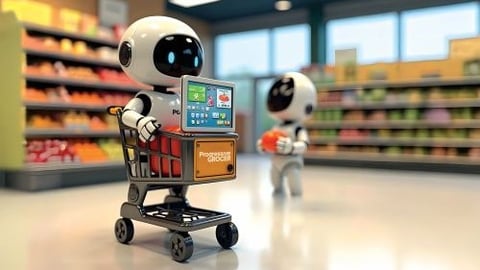How Walmart Is Winning Value Shoppers
In 2025, Walmart isn’t just selling more groceries than anyone else – it’s redefining what a modern grocer should be.
As grocery retailers face relentless pressure to surpass shopper expectations and sink capital into omnichannel capabilities, Walmart is investing across the customer value proposition to truly transform the food shopping experience in 2025.
In an exclusive interview with Progressive Grocer, the EVP of the Walmart U.S. food business, John Laney, offers a comprehensive look at how the company is accelerating its ability to serve shoppers how they want to be served in the moment, like whether they need chips and salsa – or an extra folding table and a couple of chairs – for Game Day. Walmart is accelerating growth now by strengthening its focus on value, convenience and innovation at a time when grocers really need to excel at all of these things.
Winning the ‘Choiceful’ Customer
The state of the U.S. grocery shopper in 2025 is much like the state of the grocery industry in 2025: wracked by uncertainty in the face of gloomy economic forecasts, persistent inflation and escalating trade wars. But there’s one thing that can be counted on: Today’s shoppers are in pursuit of value, although the definition of “value” is continually changing.
“Customers are choiceful in their spending and looking for value – saving money and time – and we’re prepared to deliver both,” says Laney. “A recent example is our Game Day Basket, which offered customers everything needed to host a football watch party, for about $8 per person. It was available both in-store and online. With just one click, customers could add all the items into their cart for pickup or delivery, and it performed extremely well – customers appreciated the low prices and the convenience.”
Walmart’s investments in value are actually a little bit more complex; “curated value” is more like it, and these investments have certainly been paying off for the company.
This past February, Walmart U.S. – with 1.6 million associates and 4,616 stores – reported fiscal 2025 revenue up 4.7% year over year to $462 billion, bolstered by consistent momentum across grocery and e-commerce. Omni grocery specifically continues to power the engine at Walmart U.S., with mid-single-digit comp growth driven by higher transaction counts and unit volumes in fiscal 2025. The company’s Sam’s Club business also reported 4.7% growth in fiscal 2025 revenue to $90 billion, led by sales in food and health-and-wellness categories.
Walmart U.S. is seeing especially strong performance across fresh categories such as dairy, meat, produce and floral. Further, increased share across income levels, notably among higher-income households, suggests an ever-widening appeal for the retailer as a grocery destination.
[RELATED: Walmart's E-Grocery Attracts Higher-Income Shoppers]
“Customers want four things from us: great assortment of items, low prices, an easy shopping experience and to do business with a retailer they trust. It’s important to deliver on all four to create meaningful value for customers,” notes Laney. “Walmart grocery has grown share among higher-income customers. The value proposition is the same for everyone – a great assortment, available when you want it at Every Day Low Prices [EDLP], and all delivered through a seamless shopping experience – in store or online. As merchants, our role is to find the assortment, prices and experience that fit all customers. Everyone wants to save money and time, regardless of income.”
Many higher-income shoppers discovered Walmart’s online grocery offering for the first time during the pandemic. Now many of them are hooked on the retailer’s blend of value and convenience, whether that means having their refrigerators stocked with milk by a Walmart associate or having cough drops delivered by drone.
“Increasingly, we are becoming known for convenience as much as price,” observes Laney. “Being able to get delivery in as little as 30 minutes or pick up an order or even have it delivered into your refrigerator – this is appealing to many new customers.”
Once new customers try Walmart for food, they often explore nonfood categories. “What’s unique at Walmart is the ability to save money on, say, groceries, but our new customers soon discover we also have great fashion, beauty and general merchandise, all at Every Day Low Prices,” adds Laney.
The company sees this as a long-term opportunity to retain and deepen engagement with these shoppers by delivering elevated quality, innovative products and frictionless experiences. An emphasis on localizing assortments also doesn’t hurt.
“We continue to focus on personalizing the store assortment based on customer preferences for that local community,” affirms Laney. This may include assorting regionally popular brands, customizing seasonal offerings, or highlighting locally grown produce and goods. The goal is to make every Walmart feel “local” while still delivering on the company’s value at national scale. At the core of this strategy focused on product innovation and hyper-local is its merchant team, whose members Laney describes as deeply passionate about finding the next big thing.
“A merchant is one of the most fun jobs in the company,” he asserts. “I lead a team of merchants who are the best in the business, and one of the reasons is that they always keep the customer at the center of everything. They really are America’s personal shoppers!”
[PODCAST: What Is Walmart's Merchandising Strategy?]
Laney highlights Walmart’s unique product discovery ecosystem, which includes its annual Open Call event. “Our merchants are continuously on the lookout for new, innovative items, and we discover them in many ways – from our current suppliers; to our annual Open Call event where suppliers pitch items that are made, grown or assembled in the U.S.; to even social media,” he says. “New items should solve a customer problem or surprise and delight them, and always provide value.”
This treasure-hunt merchandising culture encourages calculated risk-taking to keep shelves fresh and exciting, and strengthens Walmart’s reputation among shoppers as a destination for both essentials and unexpected finds. The model echoes the strategies of specialty grocers but is executed at mass scale.
Walmart is leveraging this curation both online and in stores as the company continues to invest heavily in remodels. The retailer is expanding refrigeration capacity and optimizing sales floor design to emphasize a focus on fresh.
“Our fresh business has significantly grown over the past several years, in part due to the popularity of pickup and delivery,” explains Laney. “We’ve expanded our assortment, including across tropicals, grape varieties and salad kits.”
This growth in fresh aligns with a broader shift in consumer preference toward healthier eating and fresher options. By redesigning stores to better showcase perishable categories, Walmart is responding to increased customer demand and reinforcing its role as a primary grocery destination.
Store redesigns also reflect trends in health and wellness, which have inspired Walmart to roll out new sections.
“We are always listening to the customer,” continues Laney. “For example, in dry grocery, we saw the growth in sparkling beverages specifically with an added functional benefit, so we launched a new beverage section in store called ‘Modern Soda’ that includes beverages with a specific functional benefit, from naturally sweetened to probiotics. The distinction makes it easier for customers to shop. It includes brands such as Zevia, Poppi, Olipop and Culture Pop, and we expect to add more in the future.”
EDLP is always a constant, however.
“We also want to make new products affordable and accessible to try,” notes Laney. “We currently have $1 Poppi mini cans so customers can try the brand. We ran a very successful $1 hot sauce campaign through the holidays so customers could try a variety of different sauces at an accessible price. The move is in line with our continued expansion of emerging brands. Walmart always wants to provide customers with more choices and the wide assortment they are seeking.”
[RELATED: 76th Consumer Expenditures Study: Meet the 2025 Shopper]
Walmart’s private-brand business is also central to its value legacy, with Bettergoods (launched in 2024) emerging as a breakout success. Offering modern culinary flavors, plant-based options and allergen-free choices, the brand aims to deliver both quality and affordability. Bettergoods joins the retailer’s other store brand popular with grocery shoppers, Great Value.
“Because of the value Bettergoods is providing, we have seen new, incremental customers shopping Walmart’s private brands – in fact, more than 60% of the customers buying Bettergoods are entirely new to Walmart’s private brands,” observes Laney. “We listen to our customers and where they are headed, to address not only what they need and want today, but what the trends and insights are telling us will be popular in the future.”
The success of Bettergoods underscores the importance of strategic foresight in private-brand development. These products aren’t just margin-friendly substitutes — they’re destination drivers, especially as younger consumers and food explorers seek out novelty, global flavors and health-forward options. With more than 70% of Bettergoods items priced at $5 or less, Walmart is demonstrating that value and aspiration can coexist.
The last piece of Walmart’s food merchandising strategy is now focused on convenience, which continues to define the future of food retail. Laney shares that the number of customers wanting to spend 30 minutes or less preparing dinner has more than doubled since 2021.
“We are providing them with multiple ways to fulfill this need,” he says. “For example, hot meals can be delivered to their homes in 60 minutes or less with Express delivery or available for pickup. This includes offerings like rotisserie chicken and Marketside sides, ideal for quick, nutritious meals.
[RELATED: When Fast Food Is Good Food]
“You can feed a family of four for under $20 with a rotisserie chicken and two sides, providing incredible value with a low price and convenience,” adds Laney. The retailer is also expanding its line of more than 30 Marketside Fresh Meals and Pastas, many of which cook in under 30 minutes. The variety ranges from globally inspired flavors like truffle ravioli to Southwest chicken bowls.
As restaurant inflation persists, Walmart’s positioning as a foodservice alternative becomes more compelling. The company’s strategy isn’t just about convenience, however, it’s also about becoming a first choice for dinner.
That Convenience Piece
In February, when Walmart CEO Doug McMillon talked about the company’s strong fourth-quarter and fiscal 2025 performance, he observed that there was one thing he would alter about the company: “If I could change anything about how we’re perceived today, it would be that more people know about our breadth of assortment online and our increasing delivery speed.”
How fast is Walmart going to compete with Amazon and other companies on omnichannel retail? The retailer can already deliver hot pizza or cold milk to residents in Dallas in 15 minutes by drone. It’s offering same-day fresh- and dry-grocery fulfillment from its 4,600-plus locations to a vast swath of U.S. households. The company’s Walmart+ membership program saw double-digit growth in fiscal 2025 and a big bump from its expedited delivery services (like Express Delivery, now offered in 85% of the country), suggesting a growing cohort of time-sensitive grocery customers. Additionally, e-commerce contributed 290 basis points to U.S. comp growth in Walmart’s fourth quarter, a reflection of ongoing consumer preference for digital ordering, particularly in perishables and household essentials.
Laney emphasizes that all of this digital acceleration is fueling Walmart’s grocery growth: “We continue to expand our assortment online, including our fast-growing Marketplace, and we also provide easy-to-shop recipes online.”
With access to rich customer data and store-level analytics, Walmart’s merchandising teams can adjust quickly, based on real-time insights. Laney stresses that personalization also extends to digital experiences. Through the Walmart app and website, customers can receive tailored recommendations, reorder favorite items and discover new products based on their individual tastes. This alignment of physical and digital personalization helps Walmart build stronger relationships with its shoppers.
One of the most transformative developments, however, is delivery speed.
“During the fourth quarter, we expanded our store-fulfilled delivery catchment areas to now reach 93% of U.S. households with same-day delivery,” says Laney.
This massive reach enables Walmart to compete aggressively not just on price, but also on convenience and availability, especially in the fresh category. “Our wide assortment, quality and speed at a low price help us create a great customer experience for those shopping fresh foods,” adds Laney.
In tandem with expanding Walmart+, Express Delivery and in-home delivery, Walmart’s e-commerce strategy is centered on giving customers control and flexibility. Shoppers can build carts from a recipe, a weekly meal plan or a personalized product list, and switch seamlessly from pickup to delivery as needed.
According to Laney, reliability is key to building shopper confidence. “We know customers count on us to have what they need, when they need it,” he says. “That means our shelves must be full and our processes consistent, regardless of the region or time of year.”
Laney explains that Walmart is using sophisticated analytics and advanced technologies to increase efficiencies throughout the business. “For example, we are using more sophisticated advanced analytics to get consistent and predictable flow for inventory to stores for restocking,” he says. “This work has also been helpful for a more predictable workload for associates.”
Walmart has invested in robotics and machine learning, for example, to streamline its distribution centers, enhance order accuracy and improve labor efficiency. “We continue to invest in and leverage automation and AI to increase efficiency, accuracy and, importantly, enhance associates’ jobs,” notes Laney.
Additionally, Walmart is prioritizing transparency in advance of new regulations and consumer trends. “We are working across the industry to help advance the work outlined in the Food Safety Modernization Act (FSMA) standards and creating more visibility to the entire journey for food safety in the supply chain,” says Laney.
[RELATED: Walmart, Cropin Partner to Help Build a More Predictable Food Supply Chain]
As Walmart looks to the future, its grocery strategy remains grounded in four core promises: an attractive assortment, low prices, a frictionless customer experience and a company that the consumer can trust. One more way that the retailer is meeting this customer value proposition is through a new emphasis on better-for-you alternatives.
“We know many of our customers are looking for healthy options,” observes Laney. “We are seeing customers searching more often for products in categories like organic, gluten-free and keto, so we’ve put a focus on that and [are] helping customers have more options and make them easy to find. We recently offered a gluten-free Thanksgiving meal basket, which performed exceptionally well, as well as vegetarian options for Game Day.”
Walmart also recently partnered with the American Diabetes Association to offer customers more than 500 shoppable recipes that can help support their lifestyle goals and meal-planning needs.
“The customer engagement has been incredible, accounting for 70% of our downloaded recipes,” asserts Laney.
As shopper preferences and grocery retailing continue to evolve, Walmart’s blend of scale, agility and innovation positions it for sustained growth for years to come.










